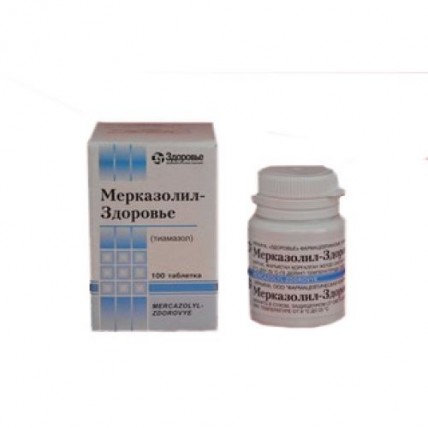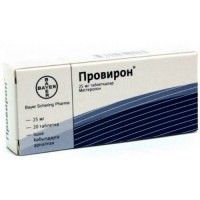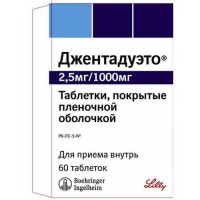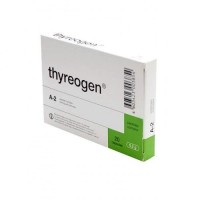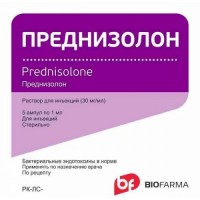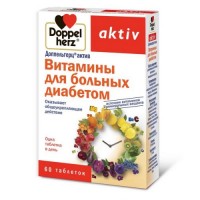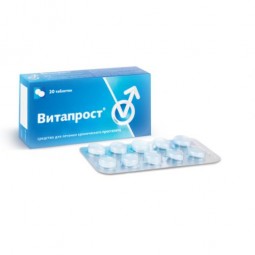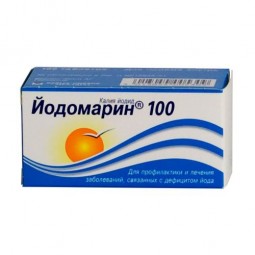Mercazolilum 100s 5 mg tablets
- $8.80
The instruction
for medical use
of MERCAZOLIL-HEALTH medicine
the Trade name
of Merkazolil-Zdorovye
the International unlicensed
name Thiamazolum Dosage Form
of the Tablet, 5 mg
One tablet contains Structure:
active agent – Thiamazolum of 5 mg,
excipients: potato starch, calcium stearate, sakharastvorafinad, talc.
The description
of the Tablet of color, white or white with a yellowish shade, with a flat surface and a facet
Pharmacotherapeutic group
Drugs for treatment of diseases of a thyroid gland. Anti-thyroid drugs. Sulfur-containing imidazole derivatives. Thiamazolum.
The ATX H03BB02 code
the Pharmacological
Pharmacokinetics Later properties of intake is quickly and almost completely soaked up from digestive tract. The bioavailability is 93%. The maximum concentration in blood is reached in 40-80 min. Practically does not contact blood proteins. Kumuliruyet in a thyroid gland. It is slowly metabolized in a thyroid gland, a liver and kidneys in this connection under a pharmacokinetic curve the plateau which remains within 24 hours after reception of a single dose is formed. The dependence of pharmacokinetic parameters on a functional condition of a thyroid gland is not revealed. Gets into breast milk and can reach in it concentration, the corresponding concentration in blood. Elimination half-life makes 3-6 hours, is prolonged at patients with a liver failure. It is removed in the form of metabolites and not changed look by kidneys (70% within 24 hours) and with bile.
The pharmacodynamics
Anti-thyroid means, slows down formation of hormones of a thyroid gland – thyroxine (T4) and triiodothyronine (T3) that allows to carry out symptomatic therapy of a thyrotoxicosis, except for cases of development of a thyrotoxicosis owing to release of hormones after destruction of cells of a thyroid gland (after treatment by radioiodine or at a tireoiodita).
The mechanism of thyreostatic action is caused by inhibition of activity of the enzyme of peroxidase participating in iodination of thyroid hormones of a thyroid gland that leads to oppression of their synthesis. Does not influence secretion of the synthesized earlier thyroid hormones therefore decrease in concentration of thyroxine and triiodothyronine in blood under the influence of drug is preceded by stage of latency.
Drug normalizes metabolic processes in a thyroid gland, lowers the standard metabolic metabolism in an organism (raised at hyperfunction of a thyroid gland), accelerates removal from a thyroid gland of iodides, increases reciprocal activation of synthesis and discharge a hypophysis of thyroid stimulating hormone.
Indications
- a thyrotoxicosis
- preparation for surgical treatment of a thyrotoxicosis
- preparation for treatment of a thyrotoxicosis radioiodine
- therapy at stage of latency of effect of radioiodine (prior to effect of radioiodine within 4-6 months)
- long maintenance therapy of a thyrotoxicosis in exceptional cases when the general condition of the patient or other individual reasons do not allow performing radical treatment
- prevention of a thyrotoxicosis when prescribing drugs of iodine (including iodinated X-ray contrast drugs) in the presence of a latent thyrotoxicosis, autonomous adenomas or a thyrotoxicosis in the anamnesis
Appoint the Route of administration and doses inside, after a meal, without chewing, washing down with enough liquid. The initial and supporting doses are established individually. The daily dose is appointed in one step or divided into 2–3 single doses. In an initiation of treatment the single doses accept during the day through identical periods. The maintenance dose is accepted in 1 reception after a breakfast.
Adults
the Thyrotoxicosis
Depending on severity of a disease drug appoint 10-40 mg (2-8 tablets) in a daily dose. After normalization of function of a thyroid gland (usually in 3-8 weeks) pass to reception of a maintenance dose 5-20 mg (1-4 tablets) a day. Duration of therapy is from 6 months to 2 years (on average – 1 year). The possibility of extension of the period of remission depends on therapy duration.
Preparation for surgical treatment of a thyrotoxicosis
Appoint in a daily dose 20-40 mg (4-8 tablets) before achievement of an euthyroid state within 3-4 weeks before the planned operation (in individual cases drug begins to be used earlier) and stop accepting in 1 day prior to operation. During the last 10 days before operation the surgeon can appoint in addition iodine drugs for strengthening of tissues of thyroid gland.
Preparation for treatment of a thyrotoxicosis radioiodine
Appoint in a daily dose 20-40 mg (4-8 tablets) before achievement of an eutiroidny state. It is necessary to consider that derivative thioureas can reduce sensitivity of tissues of thyroid gland in relation to radiation therapy.
Therapy at stage of latency of effect of radioiodine
Depending on severity of a disease drug appoint in a daily dose 5-20 mg (1-4 tablets) prior to effect of radioiodine.
Long maintenance therapy of a thyrotoxicosis
Appoint minimum effective doses – 2.5-10 mg a day, if necessary perhaps additional prescribing of left thyroxine. In need of appointment in a dose of 2.5 mg it is necessary to use drug with the corresponding dosage.
Prevention of a thyrotoxicosis when prescribing drugs of iodine (including cases of use of iodinated X-ray contrast means) in the presence of a latent thyrotoxicosis, autonomous adenomas or a thyrotoxicosis in the anamnesis
the Recommended dose of drug makes 10-20 mg (2-4 tablets) a day and 1 g of perchlorate daily within 10 days before reception of iodinated means.
Patients with a liver failure
Appoint minimum effective dose of drug under careful medical control.
Patients with a tracheostenosis and significant increase in the sizes of a thyroid gland
Apply during the short period as long effect of drug can lead to increase in the sizes of a thyroid gland.
Children
to Children from 3 to 17 years drug appoint in an initial dose 0.3-0.5 mg/kg of body weight a day. The maintenance dose makes 0.2-0.3 mg/kg of body weight a day. If necessary in addition appoint left thyroxine.
Doses and duration of treatment are defined by individually attending physician.
Side effects
the Majority of side effects of a dozozavisima also arise in the first 4-8 weeks of treatment. At development of side effects reduce a dose of drug or stop its reception.
From the system of blood and lymphatic system
Infrequently
- a leukopenia, an agranulocytosis
Seldom
- aplastic anemia, a prothrombinopenia, thrombocytopenia, a pancytopenia
Very seldom
- a generalized lymphadenopathy
from nervous system
Seldom
- a headache, dizziness
it is Very rare
- neuritis, polyneuropathy
from a digestive tract
Often
- nausea, vomiting
Seldom
- reversible change of flavoring feelings (dysgeusia, an ageusia)
is Very rare
- an acute inflammation of sialadens
from skin and hypodermic cellulose
Very often
- an itching, hyperaemia, skin rash, a small tortoiseshell which disappear at further therapy
Very seldom
- dermatitis of heavy degree
from a musculoskeletal system and connective tissue
Is very rare
- the arthralgia developing gradually, sometimes even in several weeks after therapy without clinical symptoms of nonspecific arthritis
Endocrine disturbances
Often
- a hypothyroidism, thyroid hyperplasia, fever,
is rare
- an insulin autoimmune syndrome with sharp decrease in concentration of glucose in
Disturbance blood from a metabolism, metabolism
Often
- increase in body weight (due to decrease patholologically in the increased power consumption in a hyperthyroidism that can demonstrate power exchange normalization)
from a gepatobiliarny system
Very seldom
- an abnormal liver function, cholestatic jaundice, the toxic
hepatitis Other Is Frequent
- weakness
Seldom
- increase in postoperative bleeding of a thyroid gland
- fervescence
is Very rare
- a system lupus erythematosus
- nephrite
- an alopecia
- a Quincke's edema.
Contraindications
- the increased individual sensitivity to drug, derivatives of thiourea and/or to other components of drug
- an agranulocytosis
- injury of marrow at the therapy which is carried out earlier by carbimazole
or Thiamazolum
- a granulocytopenia (including in the anamnesis)
- a cholestasia before an initiation of treatment
- joint therapy by Thiamazolum and thyroid hormones during pregnancy
- the feeding period a breast
- the children's age up to 3 years
Medicinal interactions
At simultaneous use of Merkazolila-Zdorovye with pyramidon and its analogs, streptocides increases risk of development of a leukopenia. The efficiency of drug is increased by a lack of iodine of an organism, lithium drugs, b-adrenoblockers (especially during preparation for subtotal thyroidectomy), reserpine, Amiodaronum, gentamycin, reduce – excess of iodine (potassium iodide, iodine).
Drug reduces sensitivity of tissue of thyroid gland to radiation therapy, efficiency of anticoagulants (coumarin, derivatives of an indandion), increases clearance of b-blockers.
Risk of development of a leukopenia decreases at simultaneous use with leucogenum and folic acid.
It is necessary to consider that in a thyrotoxicosis the metabolism and elimination of various medicines accelerates, and restoration of function of a thyroid gland can demand correction of the mode of dosing. After achievement of an euthyroid state at the patients accepting Merkazolil-Zdorovye for treatment of a thyrotoxicosis the change of doses of at the same time used drugs can be required: reduction of doses of cardiac glycosides, Aminophyllinum, increase in doses of warfarin and other anticoagulants (derivatives of coumarin and indandion).
At co-administration with Amiodaronum there can be a need for a dose decline of Merkazolila-Zdorovye.
Special instructions
Patients with significant increase in the sizes of a thyroid gland and a tracheostenosis should use drug with care and during shorter period.
Before an initiation of treatment it is necessary to pay special attention to agranulocytosis symptoms (stomatitis, pharyngitis, high temperature of a body). In case of development of any of above-mentioned symptoms, especially in the 1st week of treatment, it is necessary to stop administration of drug and to see immediately a doctor for performing blood test.
The excess of drug in an organism after reception of very high doses can lead to development of a subclinical/clinical hypothyroidism or increase in the sizes of a thyroid gland due to increase in level of thyroid stimulating hormone. Therefore the dose of drug should be reduced after achievement of conditions of metabolism of normally functioning thyroid gland and in addition to appoint left thyroxine.
Manifestations or deterioration in endocrine pathology of an eyeball does not depend on the course of treatment appointed for a thyroid disease. Similar complications are not the reason for change of the mode of treatment (anti-thyroid medicines, operation, radiotheraphy) and are not side reaction at the correct carrying out a course of treatment.
In isolated cases after carrying out a course of anti-thyroid therapy without any additional measures the late hypothyroidism can be shown. It is not side reaction on drug, and result of the inflammatory and destructive processes in a parenchyma of a thyroid gland caused by a basic disease.
Drug contains sakharastvorafinad that should be considered to patients with diabetes.
The premature termination of treatment can lead to a disease recurrence.
Pregnancy and the period of a lactation
At pregnancy the use of drug is possible only in urgent cases when the expected therapeutic effect exceeds potential risk for a fruit. In this case drug is appointed in minimum effective doses allowing to support the level of hormones of a thyroid gland on the upper bound of norm without additional use of hormonal drugs of a thyroid gland. The high dose can cause formation of a craw and a hypothyroidism in a fruit.
In the period of a lactation the treatment of a thyrotoxicosis if necessary can be continued in the minimum doses (no more than 10 mg/days) under control of function of a thyroid gland at newborns as Thiamazolum gets into breast milk that can cause risk of development of a hypothyroidism in babies.
Features of influence of medicine on ability to run vehicles and potentially dangerous mechanisms
Data on influence of drug on ability to run vehicles and to carry out potentially dangerous types of activity are absent. It is necessary to consider a possibility of development of side effects (a headache, dizziness, weakness and others) drug.
Overdose
Symptoms: nausea, vomiting, pains in epigastriums, fever, an arthralgia, an itching of skin, hypostases. Aplastic anemia (pancytopenia) or an agranulocytosis can demonstrate during the first hours. More rare — hepatitis, a nephrotic syndrome, exfoliative dermatitis, neuropathy, oppression or stimulation of the central nervous system.
Treatment: gastric lavage, activated carbon, symptomatic therapy.
The chronic overdose of Thiamazolum leads to an enlargement of the thyroid gland and development of a hypothyroidism. In this case drug treatment is stopped. Replacement therapy by left thyroxine is carried out in case it comes true severity of a hypothyroidism. As a rule, after cancellation of Thiamazolum the spontaneous restoration of function of a thyroid gland is observed.
The form of release and packing
On 50 or 100 tablets place in a container plastic for medicines, supplied with a cover with control of the first opening. The free space in a container is filled with hygroscopic medical cotton. On a container paste the label.
On 1 container together with the instruction for medical use in the state and Russian languages place in a cardboard box.
Storage conditions
In the dry, protected from light place, at a temperature from 8 °C to 25 °C.
To store out of children's reach!
Not to use a period of storage of 5 years after expiry date.
Prescription status
According to the prescription.
LLC Pharmaceutical Company Zdorovye producer.
Ukraine, 61013, Kharkiv, Shevchenko St., 22.
Owner of the registration certificate
of LLC Pharmaceutical Company Zdorovye, Ukraine.
The address of the organization accepting in the territory of the Republic of Kazakhstan claims from consumers on quality of products (goods) of Pharm-Euro LLP 050039, Almaty, Mailing St., 72, apartment 34 Ph.: +7 (727) 271-10-17Факс: +7(727) 271-84-97E-mail:
To Develop farmevro@mail.ru
for medical use
of MERCAZOLIL-HEALTH medicine
the Trade name
of Merkazolil-Zdorovye
the International unlicensed
name Thiamazolum Dosage Form
of the Tablet, 5 mg
One tablet contains Structure:
active agent – Thiamazolum of 5 mg,
excipients: potato starch, calcium stearate, sakharastvorafinad, talc.
The description
of the Tablet of color, white or white with a yellowish shade, with a flat surface and a facet
Pharmacotherapeutic group
Drugs for treatment of diseases of a thyroid gland. Anti-thyroid drugs. Sulfur-containing imidazole derivatives. Thiamazolum.
The ATX H03BB02 code
the Pharmacological
Pharmacokinetics Later properties of intake is quickly and almost completely soaked up from digestive tract. The bioavailability is 93%. The maximum concentration in blood is reached in 40-80 min. Practically does not contact blood proteins. Kumuliruyet in a thyroid gland. It is slowly metabolized in a thyroid gland, a liver and kidneys in this connection under a pharmacokinetic curve the plateau which remains within 24 hours after reception of a single dose is formed. The dependence of pharmacokinetic parameters on a functional condition of a thyroid gland is not revealed. Gets into breast milk and can reach in it concentration, the corresponding concentration in blood. Elimination half-life makes 3-6 hours, is prolonged at patients with a liver failure. It is removed in the form of metabolites and not changed look by kidneys (70% within 24 hours) and with bile.
The pharmacodynamics
Anti-thyroid means, slows down formation of hormones of a thyroid gland – thyroxine (T4) and triiodothyronine (T3) that allows to carry out symptomatic therapy of a thyrotoxicosis, except for cases of development of a thyrotoxicosis owing to release of hormones after destruction of cells of a thyroid gland (after treatment by radioiodine or at a tireoiodita).
The mechanism of thyreostatic action is caused by inhibition of activity of the enzyme of peroxidase participating in iodination of thyroid hormones of a thyroid gland that leads to oppression of their synthesis. Does not influence secretion of the synthesized earlier thyroid hormones therefore decrease in concentration of thyroxine and triiodothyronine in blood under the influence of drug is preceded by stage of latency.
Drug normalizes metabolic processes in a thyroid gland, lowers the standard metabolic metabolism in an organism (raised at hyperfunction of a thyroid gland), accelerates removal from a thyroid gland of iodides, increases reciprocal activation of synthesis and discharge a hypophysis of thyroid stimulating hormone.
Indications
- a thyrotoxicosis
- preparation for surgical treatment of a thyrotoxicosis
- preparation for treatment of a thyrotoxicosis radioiodine
- therapy at stage of latency of effect of radioiodine (prior to effect of radioiodine within 4-6 months)
- long maintenance therapy of a thyrotoxicosis in exceptional cases when the general condition of the patient or other individual reasons do not allow performing radical treatment
- prevention of a thyrotoxicosis when prescribing drugs of iodine (including iodinated X-ray contrast drugs) in the presence of a latent thyrotoxicosis, autonomous adenomas or a thyrotoxicosis in the anamnesis
Appoint the Route of administration and doses inside, after a meal, without chewing, washing down with enough liquid. The initial and supporting doses are established individually. The daily dose is appointed in one step or divided into 2–3 single doses. In an initiation of treatment the single doses accept during the day through identical periods. The maintenance dose is accepted in 1 reception after a breakfast.
Adults
the Thyrotoxicosis
Depending on severity of a disease drug appoint 10-40 mg (2-8 tablets) in a daily dose. After normalization of function of a thyroid gland (usually in 3-8 weeks) pass to reception of a maintenance dose 5-20 mg (1-4 tablets) a day. Duration of therapy is from 6 months to 2 years (on average – 1 year). The possibility of extension of the period of remission depends on therapy duration.
Preparation for surgical treatment of a thyrotoxicosis
Appoint in a daily dose 20-40 mg (4-8 tablets) before achievement of an euthyroid state within 3-4 weeks before the planned operation (in individual cases drug begins to be used earlier) and stop accepting in 1 day prior to operation. During the last 10 days before operation the surgeon can appoint in addition iodine drugs for strengthening of tissues of thyroid gland.
Preparation for treatment of a thyrotoxicosis radioiodine
Appoint in a daily dose 20-40 mg (4-8 tablets) before achievement of an eutiroidny state. It is necessary to consider that derivative thioureas can reduce sensitivity of tissues of thyroid gland in relation to radiation therapy.
Therapy at stage of latency of effect of radioiodine
Depending on severity of a disease drug appoint in a daily dose 5-20 mg (1-4 tablets) prior to effect of radioiodine.
Long maintenance therapy of a thyrotoxicosis
Appoint minimum effective doses – 2.5-10 mg a day, if necessary perhaps additional prescribing of left thyroxine. In need of appointment in a dose of 2.5 mg it is necessary to use drug with the corresponding dosage.
Prevention of a thyrotoxicosis when prescribing drugs of iodine (including cases of use of iodinated X-ray contrast means) in the presence of a latent thyrotoxicosis, autonomous adenomas or a thyrotoxicosis in the anamnesis
the Recommended dose of drug makes 10-20 mg (2-4 tablets) a day and 1 g of perchlorate daily within 10 days before reception of iodinated means.
Patients with a liver failure
Appoint minimum effective dose of drug under careful medical control.
Patients with a tracheostenosis and significant increase in the sizes of a thyroid gland
Apply during the short period as long effect of drug can lead to increase in the sizes of a thyroid gland.
Children
to Children from 3 to 17 years drug appoint in an initial dose 0.3-0.5 mg/kg of body weight a day. The maintenance dose makes 0.2-0.3 mg/kg of body weight a day. If necessary in addition appoint left thyroxine.
Doses and duration of treatment are defined by individually attending physician.
Side effects
the Majority of side effects of a dozozavisima also arise in the first 4-8 weeks of treatment. At development of side effects reduce a dose of drug or stop its reception.
From the system of blood and lymphatic system
Infrequently
- a leukopenia, an agranulocytosis
Seldom
- aplastic anemia, a prothrombinopenia, thrombocytopenia, a pancytopenia
Very seldom
- a generalized lymphadenopathy
from nervous system
Seldom
- a headache, dizziness
it is Very rare
- neuritis, polyneuropathy
from a digestive tract
Often
- nausea, vomiting
Seldom
- reversible change of flavoring feelings (dysgeusia, an ageusia)
is Very rare
- an acute inflammation of sialadens
from skin and hypodermic cellulose
Very often
- an itching, hyperaemia, skin rash, a small tortoiseshell which disappear at further therapy
Very seldom
- dermatitis of heavy degree
from a musculoskeletal system and connective tissue
Is very rare
- the arthralgia developing gradually, sometimes even in several weeks after therapy without clinical symptoms of nonspecific arthritis
Endocrine disturbances
Often
- a hypothyroidism, thyroid hyperplasia, fever,
is rare
- an insulin autoimmune syndrome with sharp decrease in concentration of glucose in
Disturbance blood from a metabolism, metabolism
Often
- increase in body weight (due to decrease patholologically in the increased power consumption in a hyperthyroidism that can demonstrate power exchange normalization)
from a gepatobiliarny system
Very seldom
- an abnormal liver function, cholestatic jaundice, the toxic
hepatitis Other Is Frequent
- weakness
Seldom
- increase in postoperative bleeding of a thyroid gland
- fervescence
is Very rare
- a system lupus erythematosus
- nephrite
- an alopecia
- a Quincke's edema.
Contraindications
- the increased individual sensitivity to drug, derivatives of thiourea and/or to other components of drug
- an agranulocytosis
- injury of marrow at the therapy which is carried out earlier by carbimazole
or Thiamazolum
- a granulocytopenia (including in the anamnesis)
- a cholestasia before an initiation of treatment
- joint therapy by Thiamazolum and thyroid hormones during pregnancy
- the feeding period a breast
- the children's age up to 3 years
Medicinal interactions
At simultaneous use of Merkazolila-Zdorovye with pyramidon and its analogs, streptocides increases risk of development of a leukopenia. The efficiency of drug is increased by a lack of iodine of an organism, lithium drugs, b-adrenoblockers (especially during preparation for subtotal thyroidectomy), reserpine, Amiodaronum, gentamycin, reduce – excess of iodine (potassium iodide, iodine).
Drug reduces sensitivity of tissue of thyroid gland to radiation therapy, efficiency of anticoagulants (coumarin, derivatives of an indandion), increases clearance of b-blockers.
Risk of development of a leukopenia decreases at simultaneous use with leucogenum and folic acid.
It is necessary to consider that in a thyrotoxicosis the metabolism and elimination of various medicines accelerates, and restoration of function of a thyroid gland can demand correction of the mode of dosing. After achievement of an euthyroid state at the patients accepting Merkazolil-Zdorovye for treatment of a thyrotoxicosis the change of doses of at the same time used drugs can be required: reduction of doses of cardiac glycosides, Aminophyllinum, increase in doses of warfarin and other anticoagulants (derivatives of coumarin and indandion).
At co-administration with Amiodaronum there can be a need for a dose decline of Merkazolila-Zdorovye.
Special instructions
Patients with significant increase in the sizes of a thyroid gland and a tracheostenosis should use drug with care and during shorter period.
Before an initiation of treatment it is necessary to pay special attention to agranulocytosis symptoms (stomatitis, pharyngitis, high temperature of a body). In case of development of any of above-mentioned symptoms, especially in the 1st week of treatment, it is necessary to stop administration of drug and to see immediately a doctor for performing blood test.
The excess of drug in an organism after reception of very high doses can lead to development of a subclinical/clinical hypothyroidism or increase in the sizes of a thyroid gland due to increase in level of thyroid stimulating hormone. Therefore the dose of drug should be reduced after achievement of conditions of metabolism of normally functioning thyroid gland and in addition to appoint left thyroxine.
Manifestations or deterioration in endocrine pathology of an eyeball does not depend on the course of treatment appointed for a thyroid disease. Similar complications are not the reason for change of the mode of treatment (anti-thyroid medicines, operation, radiotheraphy) and are not side reaction at the correct carrying out a course of treatment.
In isolated cases after carrying out a course of anti-thyroid therapy without any additional measures the late hypothyroidism can be shown. It is not side reaction on drug, and result of the inflammatory and destructive processes in a parenchyma of a thyroid gland caused by a basic disease.
Drug contains sakharastvorafinad that should be considered to patients with diabetes.
The premature termination of treatment can lead to a disease recurrence.
Pregnancy and the period of a lactation
At pregnancy the use of drug is possible only in urgent cases when the expected therapeutic effect exceeds potential risk for a fruit. In this case drug is appointed in minimum effective doses allowing to support the level of hormones of a thyroid gland on the upper bound of norm without additional use of hormonal drugs of a thyroid gland. The high dose can cause formation of a craw and a hypothyroidism in a fruit.
In the period of a lactation the treatment of a thyrotoxicosis if necessary can be continued in the minimum doses (no more than 10 mg/days) under control of function of a thyroid gland at newborns as Thiamazolum gets into breast milk that can cause risk of development of a hypothyroidism in babies.
Features of influence of medicine on ability to run vehicles and potentially dangerous mechanisms
Data on influence of drug on ability to run vehicles and to carry out potentially dangerous types of activity are absent. It is necessary to consider a possibility of development of side effects (a headache, dizziness, weakness and others) drug.
Overdose
Symptoms: nausea, vomiting, pains in epigastriums, fever, an arthralgia, an itching of skin, hypostases. Aplastic anemia (pancytopenia) or an agranulocytosis can demonstrate during the first hours. More rare — hepatitis, a nephrotic syndrome, exfoliative dermatitis, neuropathy, oppression or stimulation of the central nervous system.
Treatment: gastric lavage, activated carbon, symptomatic therapy.
The chronic overdose of Thiamazolum leads to an enlargement of the thyroid gland and development of a hypothyroidism. In this case drug treatment is stopped. Replacement therapy by left thyroxine is carried out in case it comes true severity of a hypothyroidism. As a rule, after cancellation of Thiamazolum the spontaneous restoration of function of a thyroid gland is observed.
The form of release and packing
On 50 or 100 tablets place in a container plastic for medicines, supplied with a cover with control of the first opening. The free space in a container is filled with hygroscopic medical cotton. On a container paste the label.
On 1 container together with the instruction for medical use in the state and Russian languages place in a cardboard box.
Storage conditions
In the dry, protected from light place, at a temperature from 8 °C to 25 °C.
To store out of children's reach!
Not to use a period of storage of 5 years after expiry date.
Prescription status
According to the prescription.
LLC Pharmaceutical Company Zdorovye producer.
Ukraine, 61013, Kharkiv, Shevchenko St., 22.
Owner of the registration certificate
of LLC Pharmaceutical Company Zdorovye, Ukraine.
The address of the organization accepting in the territory of the Republic of Kazakhstan claims from consumers on quality of products (goods) of Pharm-Euro LLP 050039, Almaty, Mailing St., 72, apartment 34 Ph.: +7 (727) 271-10-17Факс: +7(727) 271-84-97E-mail:
To Develop farmevro@mail.ru
